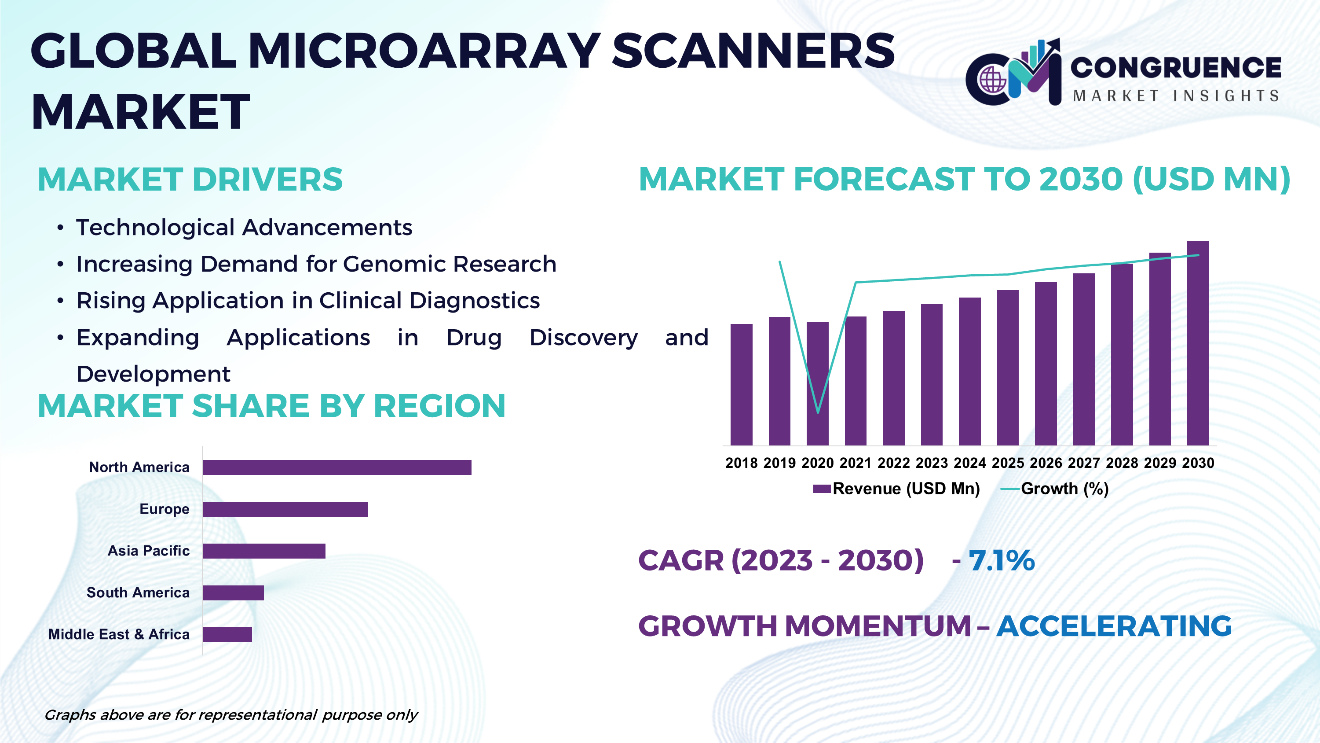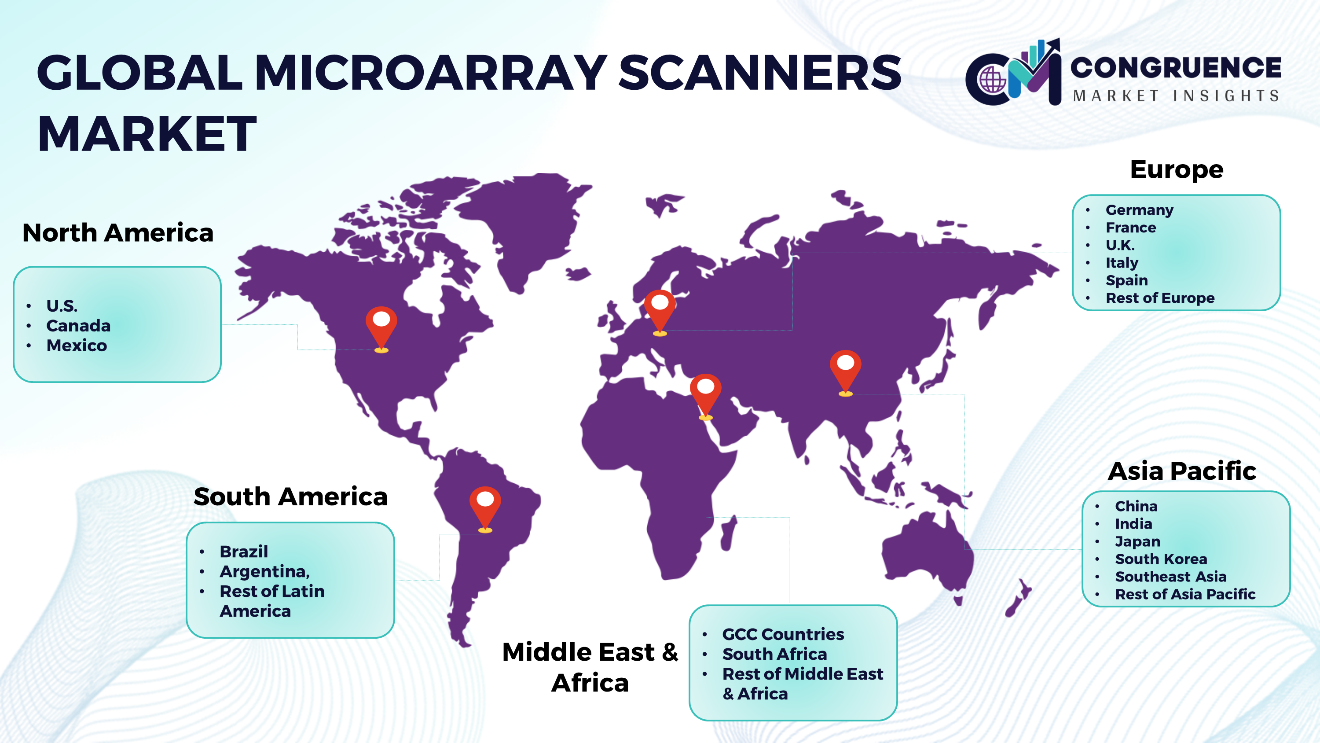Reports
The Global Microarray Scanners Market is expected to expand at a CAGR of 7.1% between 2023 and 2030. Microarray scanners comprise crucial components including lasers, photomultiplier tubes (PMTs), optics, and data acquisition systems. Technological advancements in these scanners have yielded enhanced sensitivity, resolution, and speed, facilitating high-throughput analysis of gene expression, SNP genotyping, and DNA sequencing. In terms of market landscape, the global microarray scanners market is defined by prominent players offering diverse products tailored to research, clinical diagnostics, and pharmaceutical applications. Factors propelling market expansion encompass heightened research endeavors in genomics and personalized medicine, alongside advancements in microarray technology. Nonetheless, challenges persist, such as the substantial costs of instruments and complexities associated with data analysis.

Microarray Scanners Market Major Driving Forces
Technological Advancements: Ongoing innovation in microarray scanner technology, enhancing sensitivity, resolution, and data processing capabilities, fuels market growth by enabling more efficient genetic data analysis.
Increasing Demand for Genomic Research: Growing research activities in genomics, transcriptomics, and personalized medicine drive demand for microarray scanners, vital for studying gene expression, DNA sequencing, and SNP genotyping.
Rising Application in Clinical Diagnostics: Microarray scanners find increasing utility in clinical diagnostics, aiding disease diagnosis, prognosis, and treatment selection, thereby expanding market reach as healthcare providers adopt molecular diagnostic techniques.
Expanding Applications in Drug Discovery and Development: Crucial in drug discovery and development processes, microarray scanners facilitate high-throughput screening of drug candidates and study drug-target interactions, garnering demand from pharmaceutical firms.
Microarray Scanners Market Key Opportunities
Advancement in Personalized Medicine: The surge in personalized medicine presents opportunities for microarray scanners to play a pivotal role in tailoring treatment regimens based on individual genetic profiles, driving demand for advanced genetic analysis platforms.
Integration with Artificial Intelligence (AI): Integrating AI algorithms with microarray scanners offers avenues for automated data analysis, pattern recognition, and predictive modeling, augmenting the efficiency and precision of genetic research and diagnostics.
Oncology Applications: With burgeoning research in oncogenomics and cancer biomarkers, there are opportunities for microarray scanners to facilitate cancer diagnosis, prognosis, and treatment selection, supporting precision oncology strategies.
Point-of-Care Testing Expansion: Advancements in microarray scanner miniaturization and portability open doors for point-of-care testing applications, enabling swift genetic analysis in clinical settings beyond traditional laboratories.
Microarray Scanners Market Key Trends
· Advancements in imaging technology continue to enhance resolution, sensitivity, and image quality, ensuring more precise genetic data analysis.
· There is a growing demand for high-throughput microarray scanners capable of processing large sample volumes rapidly, driven by the need for increased efficiency in genomic research and diagnostics.
· Automation features like robotic sample handling and automated data acquisition streamline workflows, reducing human error and improving overall efficiency.
· Microarray scanners find applications across diverse disciplines including genomics, transcriptomics, proteomics, and epigenetics, reflecting their growing versatility in scientific research and clinical diagnostics.
· The development of portable and point-of-care microarray scanners enables rapid genetic analysis in remote or resource-limited settings, contributing to improved access to molecular diagnostics.
· Advanced data analysis and interpretation tools are increasingly crucial for extracting meaningful insights from complex genomic datasets generated by microarray scanners.
· Integration of microarray scanners with other omics technologies such as next-generation sequencing (NGS) and mass spectrometry enables comprehensive multi-omics analysis, providing deeper insights into biological systems.
· Manufacturers are focused on reducing the cost of microarray scanners and associated consumables, making these instruments more accessible to researchers and clinicians across academic, clinical, and industrial settings.

Market Competition Landscape
Within the microarray scanners market's competitive landscape, firms vie for market share through technological innovation, superior product performance, and exceptional service quality. This competition is fueled by exacting regulatory standards and shifting customer expectations, prompting companies to distinguish themselves via comprehensive solutions and strategic collaborations. The overarching focus lies in optimizing operational efficiency, ensuring regulatory adherence, and delivering value-added services to effectively address the multifaceted requirements of researchers, clinicians, and biotechnology enterprises.
Key players in the global Microarray Scanners market implement various organic and inorganic strategies to strengthen and improve their market positioning. Prominent players in the market include:
· Agilent, Molecular Devices, LLC
· Thermo Fisher Scientific Inc.
· Bio-Rad Laboratories, Inc.
· DH Life Sciences, LLC.
· Hitachi High-Tech Corporation
· Tecan Trading AG
· Arryait Corporation (ARYC)
· Rigaku Corporation
|
Report Attribute/Metric |
Details |
|
Base Year |
2022 |
|
Forecast Period |
2023 – 2030 |
|
Historical Data |
2018 to 2022 |
|
Forecast Unit |
Value (US$ Mn) |
|
Key Report Deliverable |
Revenue Forecast, Growth Trends, Market Dynamics, Segmental Overview, Regional and Country-wise Analysis, Competition Landscape |
|
Segments Covered |
· By Product Type (Charge-Coupled Device (CCD) Microarray Scanners, Confocal Microarray Scanners, Laser Microarray Scanners, and Others) · By Application (DNA hybridization studies, Comparative Genomic Hybridization (CGH), Gene Expression Profiling, Genotyping and SNP Analysis, and Others) · By End-User (Biotechnology and Pharmaceutical Companies, Diagnostic Laboratories, Contract Research Organizations (CROs), and Academic and Research Institutes) |
|
Geographies Covered |
North America: U.S., Canada and Mexico Europe: Germany, France, U.K., Italy, Spain, and Rest of Europe Asia Pacific: China, India, Japan, South Korea, Southeast Asia, and Rest of Asia Pacific South America: Brazil, Argentina, and Rest of Latin America Middle East & Africa: GCC Countries, South Africa, and Rest of Middle East & Africa |
|
Key Players Analyzed |
Agilent, Molecular Devices, LLC, Thermo Fisher Scientific Inc., Bio-Rad Laboratories, Inc., DH Life Sciences, LLC., Hitachi High-Tech Corporation, Tecan Trading AG, Arryait Corporation (ARYC), Rigaku Corporation |
|
Customization & Pricing |
Available on Request (10% Customization is Free) |
